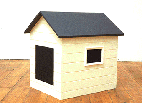|
Stephen Birch, Pets, 1995 |
Stephen
Birch |
|
Stephen Birch, Pets, 1995 |
A delusion lies at the centre
of every anthropomorphic proposition. Ultimately we are
bound by a human eye and brain, and remarking the
difference between species is as close to a fundamental
concept as we get. Stephen Birch's pethouses are no
different. They are perhaps less about dogs or pets than
they are about the human imaginary inhabiting animal form
to confront its own species' limits. Birch's installation comprised a series of kennels demarcating the front gallery space at 200 Gertrude Street according to the imagined course of an animal(s) through the gallery. The proper word for such a study or interest would be 'ethological', pertaining to animal behaviour. The kennels were paried, some two-storey, others with multiple entrances, another L-shaped, suited to a corner (one might call it 'double-fronted'). The style of each pethouse was uniform: suburban, residential, like display-home siding squeezed from a tube, supplied in running meterage and applied in only slightly different configurations. Here, as in the suburbs - (following Herald-Sun art critic Marie Sierra-Hughes) - taste has gone to the dogs. Yet the comparison with housing estates is too obvious and too simple. There's little point in suggesting that people live in the suburbs like animals and are as well-trained as Pavlov's dog. People are clearly not animals and keeping pets is also a complex kind of differentiation from them. Through pets people may return to their own lives and ratify their own tastes and desires as an animal spirit. Anthropomorphism is a vain attempt at this kind of objectivity, by transcending our physical and mental limits, and validating our lifestyle (including aesthetic) choices through the agency of other animal forms. |
| By bridging pethouses and sculpture, Birch's work
charts the collapse of anthropomorphism - as a
fundamental sculptural principle underlying 20th Century
art - into absurdity and solipsism. The architectural or
architectonic values of these residences could only
matter to a single species and our 'dog-willingness' is
nothing but a phantasmatic and errant branch of human
aesthetics. Anthropomorphism is in fact based on an
impossible advocacy of universal values; that things are
(must be) the same for you as for me. Beyond this
delusion nothing can be certain amidst a constantly
shifting set of relative propositions. The only sure
thing is the immediate subjective experience of a
previous momentary delusion. To be sure, these pethouses are not for pets (as luxury kennels are not for dogs). Rather they are absurd aesthetic forms standing in for modern sculpture. The failing of transcendental or universal aesthetic experience to account for different animal reactions reveals the particular species orientation of modern art amidst its other manifest biases. And the absurdity of this proposition casts the work as satirical. Stuart Koop |

